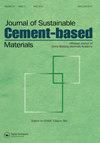新型浸辅层析成像技术研究3d打印砂浆微观结构
IF 4.2
3区 工程技术
Q1 CONSTRUCTION & BUILDING TECHNOLOGY
Journal of Sustainable Cement-Based Materials
Pub Date : 2023-03-06
DOI:10.1080/21650373.2023.2184430
引用次数: 0
摘要
本研究对3D打印砂浆的微观结构进行了研究。为了增强沙子和水泥浆之间的密度对比,采用了一种新的浸出策略作为辅助方法,在此基础上绘制了沙子在3D打印砂浆中的空间分散。同时,为了解决CT分辨率有限的问题,本研究引入了X射线衰减法(XRAM)来研究3D打印砂浆中局部孔隙率的空间分布。此外,对于单根细丝,细丝的上部比下部呈现出更低的出砂率和更高的孔隙率,并且位于3D打印砂浆顶部附近的细丝之间的差异更显著。最后,基于滑动法,3D打印砂浆的层间宽度、平均孔隙率和平均砂率分别估计为640 21.9%和43.1%。研究结果将加深对3D打印混凝土的理解。本文章由计算机程序翻译,如有差异,请以英文原文为准。
Investigation on the microstructure of a 3D-printed mortar through a novel leaching-subsidiary tomography
The microstructure of a 3D-printed mortar was investigated in present study. To enhance the density contrast between sand and cementitious slurry, a novel leaching strategy was used as an auxiliary method, based on which the spatial dispersion of sands in 3D-printed mortar was rendered. Meanwhile, to alleviate the problem of CT’s limited resolution, X-ray attenuation method (XRAM) was introduced in this study to investigate the spatial distribution of local porosity in 3D-printed mortar. Besides, focusing on single filaments, the upper part of the filaments presented lower sand rate and higher porosity than the lower part, and the difference between the filaments located near the top of 3D-printed mortar was more significant. Finally, based on the sliding method, the interlayer width, average porosity and average sand ratio of 3D-printed mortar were estimated as 640 21.9% and 43.1%, respectively. The research results would deepen the understanding of 3D-printed concrete.
求助全文
通过发布文献求助,成功后即可免费获取论文全文。
去求助
来源期刊
CiteScore
6.60
自引率
15.90%
发文量
71
期刊介绍:
The Journal of Sustainable Cement-Based Materials aims to publish theoretical and applied researches on materials, products and structures that incorporate cement. The journal is a forum for discussion of research on manufacture, hydration and performance of cement-based materials; novel experimental techniques; the latest analytical and modelling methods; the examination and the diagnosis of real cement and concrete structures; and the potential for improved cement-based materials. The journal welcomes original research papers, major reviews, rapid communications and selected conference papers. The Journal of Sustainable Cement-Based Materials covers a wide range of topics within its subject category, including but are not limited to: • raw materials and manufacture of cement • mixing, rheology and hydration • admixtures • structural characteristics and performance of cement-based materials • characterisation techniques and modeling • use of fibre in cement based-materials • degradation and repair of cement-based materials • novel testing techniques and applications • waste management

 求助内容:
求助内容: 应助结果提醒方式:
应助结果提醒方式:


